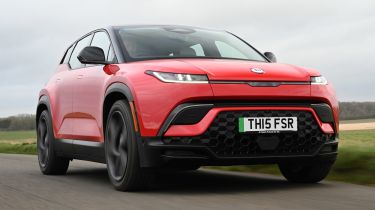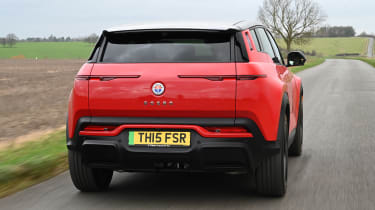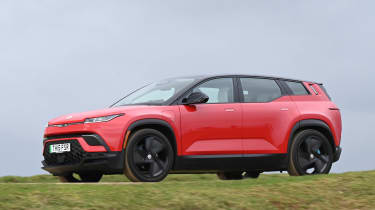New Fisker Ocean 2024 review: a serious Tesla Model Y rival
The Fisker Ocean is a distinctive and desirable electric SUV, but it’s not perfect

Verdict
The Fisker Ocean is a distinctive and desirable electric SUV. But like early Teslas, a few small changes would elevate it from average to excellent. Fisker’s first effort looks great and drives well, plus it’s packed with unique features that separate it from key rivals. Yet we can’t help but feel it would’ve made more sense to focus on what buyers expect – quality, connectivity, and real-world range, for example – than filling it with features they don’t. Many of these will get better over time, of course; over-the-air updates will be key to this car’s success.
New brands are landing in the UK on what feels like a weekly basis. Mostly from China, there’s a wave of tech-focused makers hoping to change the way we look at and live with our cars.
One stands out from the crowd, however. Hailing from California rather than Chongqing, Fisker is looking to take the electric car market by storm with its big batteries and brash styling, plus a healthy helping of self belief.
This isn’t the first time the Fisker badge has featured on the nose of an electrified family car. Fisker Inc (as it’s now known) is not to be confused with Fisker Automobiles; the hybrid Karma saloon was built in limited numbers from 2011 before the company eventually folded two years later.
Used - available now

2022 Fiat
500
22,532 milesManualPetrol1.0L
Cash £9,549
2023 Honda
Jazz
24,192 milesAutomaticPetrol1.5L
Cash £14,999
2022 Vauxhall
Corsa
30,379 milesManualPetrol1.2L
Cash £11,549
2022 MINI
5-Door Hatch
32,498 milesAutomaticPetrol1.5L
Cash £15,049Fast forward a decade and the reborn brand is in the midst of launching its first global EV – the Fisker Ocean. This is a Tesla Model Y-rivalling electric SUV with a £37k starting price, and a range of up to 440 miles in top-spec trim. Not placing all its eggs in one basket, there are smaller, more affordable models on the way, as well as a pick-up truck and a triple-motor sports car.
We first tried the Ocean on European roads last year and came away impressed by the thought and care that had evidently gone into the car’s design – not to mention a clear focus on sustainability. Now we’re driving one of the first cars to land on UK soil, in top-spec Extreme specification with the larger ‘Hyper Range’ battery.
As it stands, the entry-level Sport is the only model available with the smaller ‘Touring Range’ battery, which coupled with the less powerful single-motor configuration is good for up to 288 miles on a charge. If you need more than that, the mid-spec Ultra gets the same technical layout as our car but costs £7,000 less – forgoing some of the obvious extras fitted to flagship cars.
We were warned on collection that the car we’d be driving didn’t have the latest Ocean 2.0 operating system – myriad updates that will see small tweaks to things like torque distribution, energy management, and the climate control settings. Further changes will roll out (over the air) later in the year, adding stuff like Apple CarPlay and Android Auto, as well as radar-guided cruise control and other much-needed niceties.
While we did drive another car with the revised 2.0 software, the interior, exterior, and most of the ways the car you see here went about its business was representative of what a customer might hope to experience. Yet material quality, while generally fine, didn’t feel befitting of our Extreme’s lofty price – the door handles felt especially cheap, while some of the buttons don’t operate with the same tactility or solidity you might find in a BMW or Mercedes.
And herein lies the Fisker’s biggest problem. This is a car built to a price: £36,900 to be exact. Yet our version retailed for almost double that – with most of your money going towards the bigger battery and more powerful motor. Few manufacturers have a car that attempts to cover so many bases or span such a wide price point.
But aside from a few fundamental quality concerns, the Ocean’s rotating infotainment display was logically laid out, with a minimalist design that didn’t come at the expense of functionality. Both the main 17.1-inch screen and smaller digital instrument panel get crisp and easy to read graphics, and the climate controls are accessed via a separate dial below the central display. The TomTom navigation doesn’t feel as cutting-edge or feature-packed as some rival native systems, but the inclusion of Apple and Android software will allow owners to bypass that later down the line.
On the move, the Ocean doesn’t feel as big or unwieldy as its blocky design might suggest, though the narrow rear window doesn’t do visibility any favours. You can flick the rear-view mirror to show a digital feed, but like all similar systems, it’s not as intuitive to use as you might like. Still, the big door mirrors and elevated driving position give a reasonable view out – even if you can’t depend on countless cameras like you might in a Model Y. At least not yet.
The ride is on the firm side, but by and large it’s comfortable enough to be considered useable day-to-day. It’s nowhere near as stiff as a Polestar 2, for example, even if it can come undone by deeper potholes; catch it unawares and the Fisker will shimmy over the top of large or loose drain covers in a way a BMW iX3 would not.
This is at least partly down to the huge 22-inch wheels (we’d like to try a car on the standard 20s), but also the super-rigid body, which refuses much in the way of flex. The flip side is pretty decent body control; despite being a heavy car, it’s a relatively entertaining thing to throw around – helped by the near-560bhp dual-motor powertrain.
You can cycle through Earth, Fun and Hyper drive modes – the latter turning the 2.4-tonne SUV into a rocketship. This is an incredibly quick car in the right conditions – we did sense a bit of slip from the front wheels if you floor it away from a junction in the wet, but this is something Fisker could look to fix with a software update in time.
Speaking of which, Fisker tells us that it’ll introduce one-pedal driving in the near future – a feature that’ll make the car much easier (and hopefully more efficient) to drive around town. The current settings do allow for noticeable brake regeneration, but they won’t bring the Ocean to a complete stop. And that’s a shame, because in the first car we drove, the brake pedal did feel a little spongy. The second car felt better.
Efficiency, probably due to the huge battery, is nothing to write home about; we saw around 2.2-2.5mi/kWh during our time with the car – a figure that wouldn’t see you hit 300 miles on a charge, let alone 400 or more.
DC fast charging is rated at 180kW, however, which Fisker says is good for a 10-80 per cent top-up in 33 minutes. So even if it’s not the most economical, it is at least competitive when it comes to plugging in and getting on your way.
Refinement is so-so compared with rivals in this part of the market. Road noise was kept fairly hushed despite our car’s big wheels, but wind noise is noticeable around the A-pillars. Electric cars need to work hard to disguise unwanted sounds, and a Genesis GV70 does a better job of this overall.
But for all its compromises on the road, the Ocean acts as a favourable family car. There’s loads of room up front – even if the driving position could do with a little more adjustability – and you’ll easily fit a pair of six-foot adults in the back. The boot measures 476 litres, which is on par with a Mercedes EQC, but there’s a big well under the Fisker’s floor to store the charge cables. While the seats fold flat, the boot opening is a little shallow, which may restrict outright practicality.
To this point, though, we’ve not really touched on any of the areas that make the Ocean unique. It looks like little else on the road, and should appeal to plenty of people on SUV-style alone. It’s boxy and beautifully proportioned, and in Red Planet (an £850 option on top-spec Extreme cars), completely unique.
Touching once again on the care and thought that’s gone into the design, we must mention the Ocean’s California Mode. At the touch of a button, you can not only lower the front and rear windows, but also open the panoramic roof, rear screen and the rearmost side glass. More use on the west coast of America in the height of summer, perhaps, but we managed to enjoy it briefly – even in the windy West Midlands.
Then there’s the ‘Taco Tray’ – or ‘Fish and Chip Flap’ as our editor-in-chief coined it when he drove the car last year. This small table folds out, airline style, from the centre console and allows you to rest your lunch (or laptop) while you’re charging. It doesn’t feel the most solid surface, but it’s a neat addition that surprisingly few EVs have.
Another feature that is surely of greater significance in Los Angeles than London, is the SolarSky roof. As the name suggests, this setup can generate energy for the high-voltage battery using power from the sun. Fisker claims it could add 2,000 miles per year in ideal conditions; you’ll likely see a lot less living in the UK.
In terms of specs, even the Ocean Sport comes with the same big screen as its bigger brothers, plus heated front seats, a premium sound system and a fixed glass roof. While we’ve not yet tried it, this well-equipped base car could reasonably be considered the pick of the range, if you don’t need the super long range or dual-motor set-up.
Ocean Ultra (from £50,900) adds that bigger battery and upgraded powertrain, plus an opening panoramic roof and that trick California Mode function. Extreme, as tested here, brings things like a 3D sound system and that solar roof. All cars get 20-inch wheels as standard, though 22s can be optioned across the range.
Without a conventional dealer network, Fisker will point you to its stores – located in places like popular shopping centres such as Westfield in London. There’s another in Manchester, with more to come. Not convenient? Much of the ownership experience – both before and after taking delivery – will be done via the Fisker App. Everything from speccing your new car to arranging your next service can be done from your phone, and indeed, the comfort of your home.
| Model: | Fisker Ocean Extreme 113kWh Hyper Range |
| Price from: | £36,900 / Extreme: £57,900 / As tested: £61,725 |
| Powertrain: | 106kWh battery (usable), 2x e-motors |
| Power/torque: | 556bhp/737Nm |
| Transmission: | Single-speed auto, four-wheel drive |
| 0-62mph: | 3.9 seconds |
| Top speed: | 128mph |
| Range: | 440 miles |
| Charging: | 180kW, 10-80% in 33 mins |
| Size (L/W/H): | 4,774/1,955/1,629mm |
| On sale: | Now |











